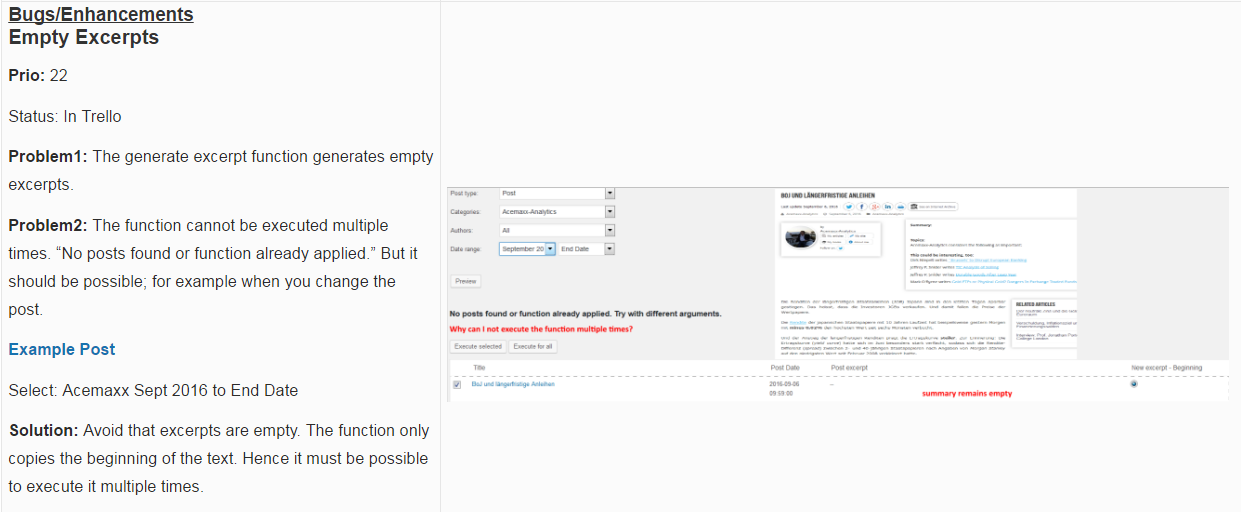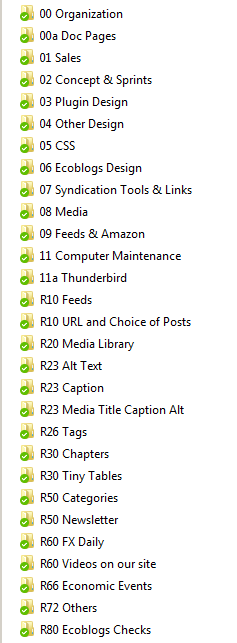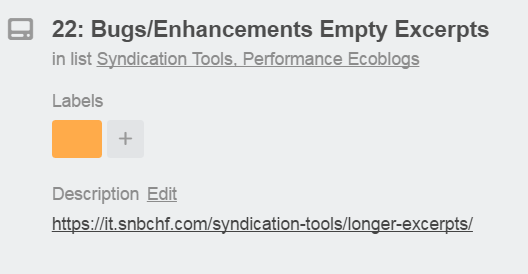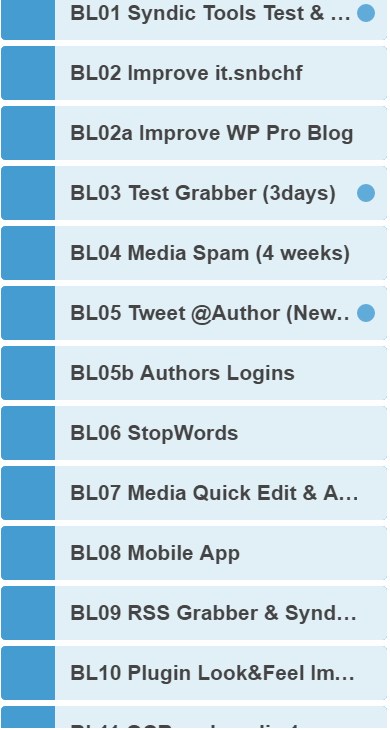Page no: O31
Explanation |
Video |
Work with Scrum Template
|
|
OverviewGeorge wants to step out as a Project Manager and be a Product Owner. He does not have enough time and must get some free time from Project management. The way of work until now leads to misunderstanding and lack of communication and viability of the sprint. |
|
VideoThe Product Manager creates a video that explains what the team should achieve or he gives feedback. |
 |
Definition of DoneThe Product Owner must add definition of done chapter for every task in the beginning of the sprint. The task will be closed only when all the requirements are done and tested by Project Manager. |
|
Checklists before Starting Task |
Checklists before Starting Task |
How to detail tasks?From now the Project Manager must write down all the steps of the task, so the Product Owner can control and see progress. The Project Manager must create a checklist named “AAA Detail the task” in the beginning of every new sprint. NO! he must copy it. The project manager follows the tasks of the AAA list. Form in Trello: Checklists DO NOT CREATE NEW AAA Lists but he creates checklists in Trello that stand for chapters and sections. Project manager decides if it is Chapter or Section. Team copies the screenshots into the relevant section/chapter. |
|
Change in Work Def of Done
|
|
Old Version of Way of WorkSummary
|
(March 13, 2017) |
How to work Part2 (with some repetition)Summary:
Example Trello: Change image Size |
(March 13, 2017) |
Create VideoShort explanation: For each of the video
|
(Apr 02, 2017) |
Input Video1. George creates videos and says which areas (00-12 or WP Pro) after the — (end of title of the video) or the page number. 1a. Sometimes he also gives priority on the video (beginning name) |
, |
| 2. Team uploads video to a input video page on it.snbchf or wordpressPro or George put the video directly a page.
(In most cases, George will put it directly to a page). |

Videos are uploaded to Input Video Pages (with 00), but they must go to normal pages later |
Add Page Number to VideoThe video shows how to find a page number for the video. All pages contain videos, text and images. |
(April 07, 2017)
|
Subfolders: Video Archive2b. Once uploaded the team moves the videos in the subfolders, which are type of video archive. |
|
Problem Description
|
New Row for a Bug, Left Text, Right Screenshot . |
Trello(is now only for work progress and checklists) 4. Niki create a card that references the page in a Video In list. 6. Niki creates a checklist who should watch the video and 7. He or the team write a detailed checklists for what needs to be done. 7. Niki and George decide together in which sprint or Backlog the tasks for the videos should be done. |
Link to the Doc Page from Trello |
| The video shows how to create a Trello card based on a video. | (April 07, 2017) |
Backlog Boards8. Niki moves the card into the right Backlog Board (BL01-BL15) based on th |
Our Backlog Boards
|
Sprint9. George creates a sprint or tells Niki which BL he should work on and create sprint. In the second case, Niki creates the sprint. |
|
| The doc is written directly on the pages (no Doc BL Board for new sprints) 12. Niki writes solution on the page after the problem description. |
Solution on DocPages . |
Finish the Doc BacklogThis is only when we move the backlog doc into the doc pages A. Niki tells on which to copy the task from the Doc BL. B. Team copies the Doc and screenshot from the Trello Card into a tiny table |
|
New Way of Work 201810We stop all computer admin related activities except some page reordering. This will include also Thunderbird. Let’s focus on the new business models that Niki is working on. Sprint is same Niki fills the tasks into the sprint that are currently missing. For questions, the team asks Niki only. Niki and George have one meeting every day on the red tasks, checklists The next step would be for Niki to create the tasks and checklists for all cards in the board and the missing tasks. Team should do the regular tasks board. George is planning to revive Economicblogs. Work for Software is done, we just need sales and contact the authors and create the tweets. Moreover, we need to document our software with step by steps, like Amazon Load, Team can be helpful. We stop documenting other people’s software, focus for the team should be more into sales and contact also small sales, contact with authors when they complain which comes when tweeting with their twitter account. There is missing little as for software, but there is missing more in learning how to communicate when they tweet back and ask questions or complain. Niki explains to the team the twitter. |
Update 2018.12We want to continue working on the computer stuff, because we learn how to create detailed checklists. |
Team:
George: Programme management and business analyst, George creates milestones and high level tasks, gives deadlines for milestones, if needed.
Niki: Project manager and programmer. Niki does the planning. He decides which low-level task is done by whom. He tries to keep the milestones.
Rad: Tester and some documentation, he finds bugs and does tasks according to Niki’s planning.
Ned: Backend programmer, does tasks according to Niki’s planning.
Ivan: CSS and design programmer, does tasks according to Niki’s planning.
George: Do user acceptance test (UAT) and reports bugs.
Software Development Cycle
Step 1: George writes the business requirements inside the design pages and the concept pages
Step 2: George and Niki write the the design at high Level on the doc pages. George specifies some estimated dead lines for each milestone.
Step 3: Niki does software design for the requirements and documents some more design details on the design and plugin pages.
Step 4: Niki explains what he is doing to Rad and is responsible for what Rad does (not George).
Step 5: Rad reads the doc pages, asks and understands it. He can add some missing information like missing links to other pages.
Step 6: Rad does so-called “functionality tests” or “unit tests“. He documents some testing in the testing menu. One example is a table of our mobile devices and if the mobile site works on that device.
Step 7: George will do “user acceptance test” afterwards.
Work principles
The way of work has some important principles:
Principle 1: Agile We change the business requirements, if it makes sense!
Principle 2: Work in tasks and Pomodori.
Principle 3: Test what you do
Principle 4: Document and, maybe, program it twice
Principle 5: Achieve good SEO with the doc.
Principle 1: Agile
In an agile work, requirements may change during the time when the software is implemented.
Principle 2: Tasks and Pomodori
Doing only one task gets bored and you get “too deep” into this task, this is not good.
The Original Pomodori Principles
(via Wikipedia)
- Decide on the task to be done
- Set the pomodoro timer to n minutes (traditionally 25)
- Work on the task until the timer rings;
- Take a short break (3–5 minutes)
- After four pomodoros, take a longer break (15–30 minutes)
Managers will work in 25 minutes pomodori, which is 25 minutes concentrated work. Then 5 minutes break for a coffee or similar. Then again 25 minutes. Managers may work with the Thunderbird tasks and Pomodori plugins.
IT staff goes for 50 minutes work and 10 minutes break for coffee or similar. IT tasks and task steps are documented in the tasks table. The organisation of task steps into Pomodori is up to the IT staff.
Example: A person works on at least 3 tasks, but has 8 Pomodori a 50 minutes.
IT staff may have 3 task, but they organize themselves how they split the tasks into 8 Pomodori.
Principle 3: Test what you do
Rad and other IT stuff should test what they do.
Example: Rad adds a new feed. However the feed does not show the images correctly. The team/Rad must do this “unit testing” and not George.
Principle 3: Document and test what you do and maybe program it twice
Knowing what you do, is very important, sometimes it is called “mindfulness”.
You know what you, only when you document what you do. Therefore we create for each task a documentation page. If we have problems with this task and the piece of software behind, then we can look at the documentation page for reference.
Documentation also helps to better understand what you do. Hence you might program things a second time, because you learned during the doc.
Principle 4: Achieve good SEO for documentation!
For all our documentation pages, we would like to have a good SEO score. This helps to satisfy stake holders, when they read the detailed business plan. Moreover we might use the documented pages for better SEO of our sites or even sell our pages.
Tags: documentation, tasks
See more for



